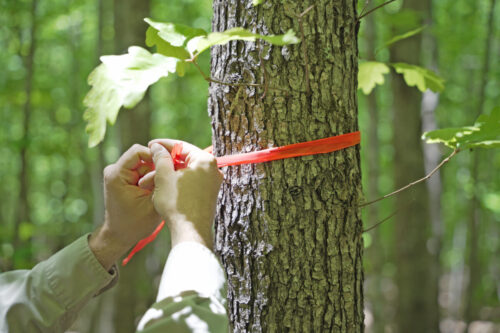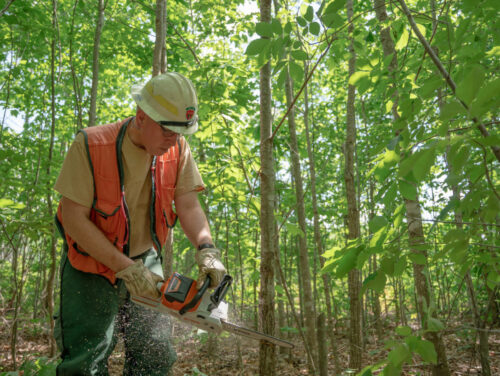

Good management helps maximize the many benefits of hardwood forests. Given the wide variety of hardwood trees – each with different characteristics – forest management can be complex. Because of these factors, it’s important for landowners to plan carefully. Forestry professionals trained in the science and art of managing forests (silviculture) can guide planning and practical actions needed to meet desired outcomes and objectives and assure healthy, productive forests for the future.
DOF foresters first conduct stand assessments using specialized tools to gather data, which is used to help inform landowner management options and decisions. In most cases, forest management falls into one of the development stages below.

During the establishment stage, management focuses on helping new seedlings germinate and grow so they can become established and compete successfully into the canopy.
Practices should be used in closed canopy, mature forests that lack desirable seedlings, especially oaks.
Prescribed Burning
Improves oak seedling establishment and competition. May aid in preparing seedbed for germination of light, windblown seeds.
Mid-Story Removal
Removes trees from below the upper canopy to improve growth and competition of small oak seedlings and saplings.
Competition Control
Reduces number of non-native plants or excessive, dense native plants that inhibit early growth of desirable trees.
Hardwood Afforestation
Planting non-forestland with at least 50% hardwood trees. Planting must follow Virginia Hardwood Planting Guidelines.

During the regeneration stage, management focuses on removing the canopy, so the established seedlings grow and form a new forest.
Practices should be used in mature forests when desirable regeneration is present or expected to start after harvesting.
Removes all trees at once. Appropriate when sufficient advanced oak regeneration is present, or to regrow trees requiring full sunlight.
Shelterwood
Removes all trees in two stages, separated by several years. Helps seedlings develop that do best in partial shade.
Periodic Partial Harvest
Frequent harvesting of small areas to slowly give seedlings more sunlight.
Competition Control
Reduces number of non-native plants or excessive, dense native plants that inhibit growth and development of desirable trees.

During the tending stage, management focuses on fostering optimal forest development and guides species composition to achieve desired objectives.
Practices should be used in young or middle-aged (8-50 years-old) forests after tree crowns touch each other to minimize future forest health problems and maximize benefits.
Timber Stand Improvement
Control unwanted species in the forest to improve growth, adjust species composition, or reduce vine competition. Typically pre-commercial.
Crop Tree Release
Improve growth of select trees by controlling their competition.
Commercial harvest to improve growth and vigor of existing trees.
As part of DOF’s hardwood initiative, landowners can take advantage of financial incentives for conducting many of these management practices.
Get started managing your hardwood forest.
In 1993, a crop tree study was established in a pole-sized stand consisting of black cherry (Prunus serotina Ehrh.) and northern red oak (Quercus rubra L.). Ten-year mean height growth of northern red oak exceeded that of released black cherry, but not that of unreleased black cherry crop trees. Crown expansion and diameter at breast height (dbh) growth also increased as a result of crop tree release for both species, but black cherry clear stem development was suppressed. Based on increment core analysis, dbh growth of released northern red oak crop trees in 2003 was about twice that of unreleased northern red oak, although black cherry treatment related differences in radial growth were no longer present. Ten years after crop tree release, northern red oak crown class distribution improved and black cherry crown class distribution was unchanged. These results suggest crop tree management will improve northern red oak competitiveness in pole-sized stands when growing in association with black cherry and, perhaps, other fast growing species. By Thomas M. Schuler.
Summary document of DOF’s hardwood sustainability strategy, including a description of hardwood resources, concerns and issues, and strategies.
Studying the response to thinning of a 7- to 9-year-old upland hardwood sapling stand, we found that height growth of yellow-poplar and oak trees was markedly reduced by heavy thinning. This suggests that stand density should be carefully controlled to achieve maximum benefit from thinnings in very young stands. By Rufus H. Allen, Jr. and David A. Marquis.
This study describes growth 6 years after mid-story removal of planted and natural black oak, northern red oak, and white oak, and natural red maple competition. Article by Jared M. Craig , John M. Lhotka , Jeffrey W. Stringer, Society of American Foresters. Forest Science, Volume 60, Issue 6, December 2014, Pages 1164–1171.
Forestry topic information sheet provides information about Department of Forestry’s hardwood initiative to bring focus to improving hardwood forests for future generations.
Forestry topic information sheet provides information about Department of Forestry’s Hardwood Initiative Cost-Share Program, who is eligible and what qualifies for cost share.
Forestry topic information sheet provides information about Department of Forestry’s Hardwood Initiative Tax Credit Program, who is eligible and what qualifies for the tax credit.
Forestry topic information sheet provides information about various hardwood management practices that may be used during the establishment, regeneration and tending stages to improve hardwood forests.
Brochure illustrates and explains proper planting techniques for planting bare-root hardwood seedlings. Printed copies available.
In 1988, seven study areas were established in Connecticut to examine the effects of precommercial crop tree release on bole and crown growth. Relative to unreleased trees, 4-yr diameter growth of northern red oak increased by 86%, black/scarlet oak by 65%, red maple by 56%, and black birch by 52%. Release slowed height growth of dominant and codominant oaks for only the first 2 yr. In sapling stands with few oaks in upper canopy positions, precommercial release could be used to augment oak density. Survival and diameter growth of oaks in the intermediate and suppressed crown classes increased with release intensity. Release also increased height growth of northern red oak in the suppressed crown classes. By Jeffrey S. Ward.
For prescribed fires to be effective, they must positively influence oak regeneration at one or more critical life stages: pollination, flowering, seed set, germination, establishment, seedling development and release into the canopy. The authors propose a refinement in our thinking to improve the match between management tools and objectives and provide some guidelines for thinking more ecologically about when and where to apply fire on the landscape to sustain oak-dominated forests. A very helpful key is provided on page 7 to help managers identify when fire will help managing the forest.
Brochure provides a listing of seedling species available for sale at our state Nurseries and current pricing. For more detailed species information and to order online, visit our Web Store. Printed copies available.
The purpose of this case study was to determine the impact of deer on the composition of the herbaceous and regeneration layer in two stands in the Matthews State Forest. This report summarizes the findings of this case study.
DOF foresters can assist you with your forestland, contact your local DOF forester.
For more information or questions, e-mail us or use our contact form.
Virginia Department of Forestry
900 Natural Resources Drive
Charlottesville, Virginia 22903
tel: 434.977.6555 | fax: 434.296.2369